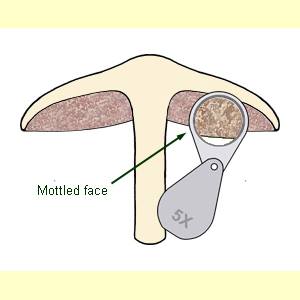
Mottling is due either to synchronous maturation of dark-spored fungi or, occasionally, to pigmented spots on otherwise pale lamellae. Synchronous maturation of spores occurs within small, localised patches on the face of the lamella, with different patches maturing at different times. This fascinating phenomenon is described and illustrated in exquisite detail by Buller (Researches on Fungi, Volume II, Chapters X to XII, 1922).
The spots or patches are up to about 1-2 mm across, are not all of the same size or shape, are sometimes interconnected, and are not in the same pattern on both sides of the same lamella. Several series of basidia can reach maturity in successive generations, with waves of maturation moving across the face of the lamella. Darker spots become paler following the discharge of spores, and the next generation of basidia in that location begin to mature.
Occasionally, mottling is caused by pigmentation of the lamellae.
